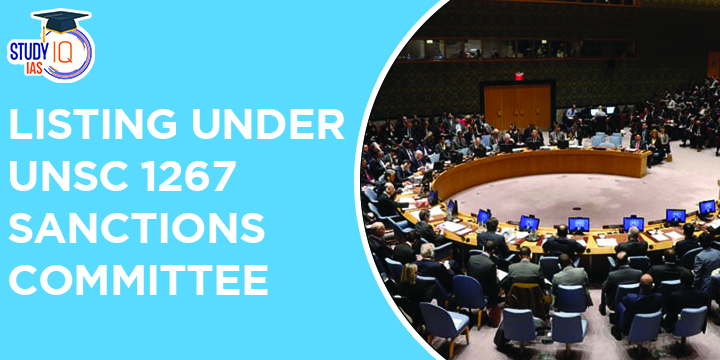Table of Contents
The 1267 United Nations Sanctions Committee
The 1267 United Nations Sanctions Committee was set up in 1999 to allow any UN member state to propose adding the name of a terrorist or terror group to a consolidated list that has affiliations to Al Qaeda and ISIS.
Members: The committee comprises of 15 members of the Security Council and makes its decision by consensus.
Functions: It is the most active UN subsidiary body working on efforts to tackle terrorism, particularly in relation to Al Qaeda and the Islamic State group.
Obligations: All the members of UN have to block access for all designated entities to funds, arms and travel outside its jurisdiction.
Previous record: India has successfully listed of several terror entities in the past, including Pakistan-based Jaish-e-Mohammed (JeM) and Lashkar-e-Taiba.
Listing Procedure Under 1267 United Nations Sanctions Committee
- As part of the listing procedure, members of the committee must give their “no-objections” to the proposal.
- If any member places a technical hold on the listing or objects outright to it, the listing cannot be adopted.
- The Committee has to resolve all such pending issues within six months. The “holding” country needs to decide whether to accept the listing or place a permanent objection to it.
- China’s hold: The committee comprises all members of the UN Security Council. Being a permanent member of UNSC, China has veto powers and can exercise it any number of times.
United Nations Sanctions Committee: Reasons for China’s Opposition
- Pakistan factor: Majority of the listing on hold by China are related to terrorists or terror groups from Pakistan, with whom China shares close ties.
- Most notable was China’s objections to the listing of JeM founder Masood Azhar. China had cited “lack of adequate information” for denying assent. Later, China had to withdraw hold after persistent pressure.
- India-US grouping: It may be possible that China does not favourably view joint effort by India and US to insert terrorists in the list. It has never given any comprehensive reason for its hold.
What Options does India have?
- International consensus: India needs to engage with all members of the UNSC Committee, including china to build consensus on listing.
- Alternative platforms: India has previously engaged with Financial Action Task Force to place Pakistan in the ‘grey list’ for failing to curb terror financing.
- Pakistan will be forced to carry out several actions against terror entities on its soil, and will continue to be under scrutiny.
- Separate listing: India and the US maintain their separate list of “most wanted” terrorists that document the cases against them, with an objective to eventually receive global cooperation on banning them.
United Nations Security Council (UNSC)
- The UNSC is one of the six major organs of the United Nations. Its primary responsibility is maintaining international peace and security.
- Members: The UNSC comprises of 15 members, of which 5 are permanent and 10 are non-permanent.
- Permanent Members: The US, the UK, the Russian Federation, China, and France.
- Non-Permanent Members: They are elected for two-year terms by the UN General Assembly based on regional quota.
- Functions:
- It can take the lead in determining the existence of a threat to the peace or act of aggression.
- It can call upon the parties to settle a dispute by peaceful means.
- The Security Council can impose sanctions or even authorize the use of force to maintain international peace and security.


 UPPSC Previous Year Question Papers, Dow...
UPPSC Previous Year Question Papers, Dow...
 Most Commonly Used Cancer Drugs and Thei...
Most Commonly Used Cancer Drugs and Thei...
 Tansen Biography, Musical Legacy and Mas...
Tansen Biography, Musical Legacy and Mas...





















